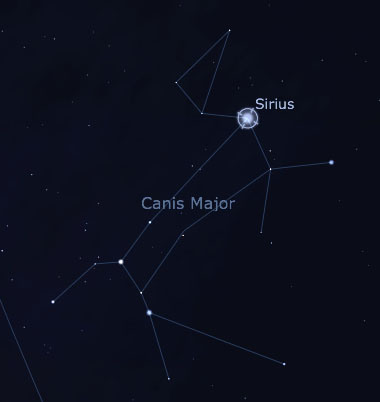Sirius
The brightest star in the night sky, Sirius has a name that means “blazing” or ‘searing”. This is certainly appropriate given that Sirius shines at the bright end of the minus-first (-1.47) magnitude. In fact, Sirius is only outshone by three planets, the Sun and the Moon.
Sirius is the luminary of the constellation Canis Major, the Greater Dog, which represents Orion’s larger hunting dog, and as such is commonly referred to as the “Dog Star”. Sirius is always easy to find. Anyone familiar with the constellation Orion can simply draw a line through Orion’s Belt, to the left. This line will point to Sirius, which is roughly 8 times as far from the Belt as the Belt is wide.
Sirius is not alone in the sky, its companion star Sirius (B), a white dwarf, is much fainter and difficult to see given the glare of Sirius. The two binary stars are 19.8 Astronomical Units away from one another, which equates to the distance between our Sun and Neptune. The two Sirius stars orbit one another taking 50.1 years to complete a full orbit. In the nights sky however, without binoculars or telescope, they look like one star.

.
Sirius Overview:
- Constellation Canis Major
- Alpha (α) 6h45m, -16°43′
- Type Binary star
- Magnitude -1.47
- Luminosity 26 Suns
- Spectral Type AIV
- Distance 8.6 light years
Canis Major Constellation … The Great Dog
South and east of Orion lies his great hunting dog. Canis Major is unmistakable thanks to the brilliance of Sirius, the brightest star in the sky, it also intrudes into a rich swathe of the Milky Way, and is peppered with beautiful star clusters and other bright stars.
Although Sirius’s proper name relates to its brilliance and perceived heat, it has also been associated with a dog since the earliest of times. It seems likely that this name came from the stars faithful pursuit of the hunter or giant Orion and was later applids to the entire constellation. Certainly Orion is far more obviously humanoid than Canis Major is dog-like.
Astronomy 101
